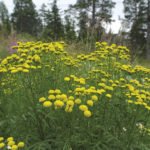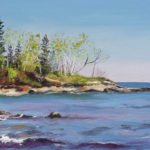Last Sunday, the dogs and I went a-roaming on the back roads north of Hovland. With no destination in mind, I was curious to see if there was bear baiting activity, new logging jobs or anything else going on. If we saw a grouse or two picking grit, so much the better. The hunting season is now less than a month away.
Well, we didn’t see any grouse. Bear baits appeared few, which may be a reflection of hunting tag availability. Logging was happening in what used to be good moose country. Maybe the habitat improvement provided by timber harvest will give the beleaguered critters a boost.
We headed west, crossing through the country north of Tom Lake. This is the Great North Woods most folks associate with the North Shore. Or used to be. There in the middle of nowhere, we encountered a sign that said: Utility Work Ahead. The government is running a long distance buried line through the woods to juice a radio communications tower, so we can be safer than we used to be. The electricity will be available to property owners along its path. Soon enough they’ll light up the woods.
Beyond Tom Lake the forest is mostly comprised of former timber company land that was subdivided and sold as recreational property. This mostly occurred during the three decades I’ve lived in Hovland. A maze of minimally maintained roads provides access to thousands of acres of woods. I can remember when this country was still the province of loggers and, in the fall, grouse hunters like me. Now the trees sprout No Trespassing signs. Drives blocked with metal gates lead to everything from tiny shacks to off-the-grid McMansions.
The signs and gates are the most visible evidence of the change that occurs when private forest ownership transforms from one large owner, such as a paper company, to many small recreational property owners. But perhaps that’s because most folks can’t see the forest for the trees. And the trees were what I most noticed. On the private lands, virtually no logging was occurring. Why? Because most folks don’t buy their own little piece of woodland paradise and then cut it down.
The policy wonks’ term for subdividing large blocks of former “working” forest into recreational properties is forest parcelization. It is considered a threat to Minnesota’s forests. Why? One reason is that the property may be converted to non-forestry uses, such as the conversion of jack pine woods to irrigated potato fields that has occurred in north-central Minnesota. Elsewhere, forests on the edge of towns may become suburban homes or box stores.
But the biggest issue is that private forest lands are less likely to be managed via logging. Economically, this means less of our forest resource is available for forest products. Ecologically, it means the unmanaged forests are more at risk from fire, insects and disease. On the North Shore, it’s easy to see what happens to unmanaged forests simply by driving along Highway 61. The iconic birch forests are dying. They are being replaced by scrub grass and brush.
The birch forests were the product of human endeavor. After the original coniferous forests were logged off about a century ago, large, intense wildfires burned up the slash the loggers left behind. This created perfect growing conditions for paper birch. Along the Shore are thousands of acres of primarily birch forests that are approximately the same age. And that’s a problem, because birch are relatively short-lived trees. Now the birch forests are dying.
Most of these birch trees are located in state parks where logging is not allowed or on private land where logging hasn’t occurred. Now it is too late to harvest and salvage the trees. Because the birch forests were essentially a monoculture, minimal new trees are taking their place. Elsewhere birch predominated in northeastern Minnesota on county, state or national forest land, the forests were harvested when they reached maturity. The disturbance created by logging spurred the regeneration of the forests, primarily as aspen and birch.
The forest near Tom Lake is a mix of boreal species: aspen, birch, balsam, spruce and pine. If left unlogged and unburned in coming decades, it is unlikely to go through a mass die-off like the birch forests. But the trees will deteriorate, die and fall down. And the forest will be vulnerable to fire, insects and disease. Change occurs slowly in the forest, so it is unlikely current or future landowners will know how or why it occurred.
Goodbye to the Hip
Last Saturday I crossed the border to join my Canadian neighbors at the Thunder Bay Auditorium to watch a nationwide CBC live broadcast of what may be the last concert of the rock band, The Tragically Hip. After announcing in May that Gord Downie, the band’s front man, was diagnosed with terminal brain cancer, the band launched a summer tour across Canada. The last concert was held in the band’s hometown of Kingston, Ontario. Although mostly unknown in the States, the Hip are to Canada what Prince was to Minnesota, only more so.
I was introduced to the band by a Minnesota friend three decades ago and they’ve been on my life soundtrack ever since. Listening to the Hip, I’ve been on fishing trips from the Atlantic to the Pacific and many places in between. I saw them live a couple of times, including once at Grandma’s Sports Garden in Duluth. Vikki and I were sure we were the only Yanks in the place, which ran out of Molson’s and LaBatt’s about halfway through the show.
Now that Vikki is gone, the band pops up more frequently on my playlist. Having walked the path with loved ones suffering with cancer, I felt compelled to see this final show. Ever the showman, Downie did not disappoint. Rare is the rocker who still looks and sounds good after three decades onstage. And once again I was reminded that all good things must come to an end.





